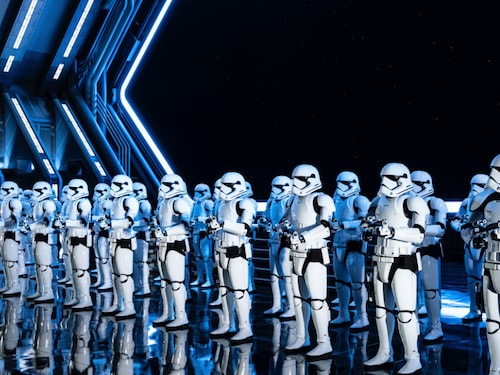Marvel, Star Wars on Disney's new streaming line-up
A blitz of new projects includes 10 series from the "Star Wars" universe for Disney+, which now has 87 million subscribers


 Image: Brian McGowan
Image: Brian McGowan
In February, Robert A. Iger stepped down as Disney’s chief executive and became executive chair, saying he would decamp entirely in 2021. But he saw himself as having one final task. “I want to make sure that our creative pipelines are vibrant,” Iger said in an interview at the time. “That is very, very important, especially as we roll out Disney+ around the world.”
On Thursday, as part of a four-hour investor presentation focused on the future of Disney’s streaming business, Wall Street got a sense of what Iger was talking about. Never have Disney’s content engines been turbocharged like this.
Disney unveiled a blitz of new “Star Wars” projects, including 10 television shows — two of which will be “Mandalorian” spinoffs, another that will follow C-3PO and R2-D2 — and a new theatrical film, “Rogue Squadron,” directed by Patty Jenkins (“Wonder Woman”). Jenkins will be the first female filmmaker in the 43-year history of the “Star Wars” movie franchise.
At least 15 Disney-branded movies are in the works for Disney+, with new installments in the “Ice Age,” “Night at the Museum,” “Diary of a Wimpy Kid,” “Sister Act” and “Cheaper by the Dozen” franchises on the way. Amy Adams will star in a sequel to the 2007 musical “Enchanted,” while Tom Hanks will appear as Geppetto in a live-action “Pinocchio.” Multiple sports dramas fill out the slate, including one based on the life of Milwaukee Bucks star Giannis Antetokounmpo.
Pixar? It has a cluster of shows en route to Disney+, including one that seeks to revive the “Cars” movie and toy franchise. Marvel? It is chipping in at least 10 series, with “Ms. Marvel,” about a Pakistani American superhero, as one. National Geographic, another Disney division, also announced a flurry of Disney+ shows, including an endurance-focused series starring Chris Hemsworth (“Thor”) and directed by Oscar winner Darren Aronofsky.
“We obviously didn’t have time to show you everything,” Iger said at the presentation’s 3 1/2-hour mark. In all, Disney announced 100 projects.
Disney+ programming costs ran about $2 billion this year. The service’s annual content budget will be roughly $8.5 billion in 2024, the company said.
With Disney’s content assembly lines running at a far faster pace than they have in the past, quality and consistency are sure to be new concerns for investors. Iger sought to assuage any such worries. “As we increase our output, the emphasis will always be on quality, not volume,” he said.
Bob Chapek, Disney’s new chief executive, disclosed that Disney’s flagship streaming service had 87 million subscribers as of Thursday, nearing the high end of its initial five-year goal after only a year in operation. Disney+ has benefited from a low monthly price ($7, though the company announced it will rise to $8 in March), a smash hit (“The Mandalorian”) and the coronavirus pandemic, which has prompted Disney to reroute theatrical releases like “Hamilton” to the service and created spiking demand from homebound consumers. A significant percentage of Disney+ subscribers — nearly 30% — come from India, where the monthly subscription price is much lower.
The company’s updated growth forecast: Disney+ will reach between 230 million and 260 million subscribers by 2025. (Netflix currently has 195 million subscribers worldwide.)
Perhaps reflecting Disney’s confidence, “Hakuna Matata,” the no-worries-for-the-rest-of-our-days tune from “The Lion King” played on the investor presentation’s link before it got underway.
Wall Street has started to value Disney less as an old-line entertainment company with challenged businesses (traditional television networks in secular decline, theme parks closed or operating with coronavirus-forced capacity restrictions) and more of a streaming colossus in the making. Disney shares reached roughly $160 in after-hours trading Thursday, an all-time high.
The out-of-the-gate success of Disney+ has generated much of the excitement. Many analysts initially thought it would be lucky to achieve 55 million subscribers within five years. Having missed the mark in such epic fashion, Wall Street is now more willing to give Disney the benefit of the doubt.
But challenges lie ahead. Building streaming services is monstrously expensive, and Disney now has four: Disney+, Hulu (39 million subscribers), ESPN+ (11.5 million) and Star+, an overseas version of Hulu that will roll out in Latin America in the coming months. Losses in Disney’s direct-to-consumer division totaled $2.8 billion in the company’s 2020 fiscal year. The company has also given up billions of dollars in licensing fees as it has amassed library content on Disney+ rather than selling to outside companies like Netflix.
Netflix and Amazon remain formidable competitors, pouring billions of dollars a year apiece into original programming. In addition, traditional entertainment companies like WarnerMedia, ViacomCBS, NBCUniversal and Discovery Communications are determined to compete with a far-out-in-front Disney for streaming subscribers.
A significant portion of the presentation was dedicated to Star, which will be stocked with programming from Disney properties like ABC, FX, Freeform, Searchlight and 20th Century Studios, which Rupert Murdoch sold to Disney last year. In Latin America, Star+ will roll out as a stand-alone service in June and also include some ESPN coverage of sporting events. (It will mostly be sold in a bundle with Disney+, the company said.)
In Europe, Canada, Australia and several other markets, Star+ will be integrated directly into Disney+, which will add a vast amount of more mature programming to the service (“Deadpool 2,” the “Family Guy” cartoon series), allowing Disney to potentially reach an audience far beyond families.
The addition of a Star channel inside Disney+ will also justify a price increase of roughly 28%, to about $11 a month.
New programming is also headed to the Disney-owned Hulu, including the series “Nine Perfect Strangers,” a mystery from David E. Kelley and starring Regina Hall, Nicole Kidman and Melissa McCarthy — what Dana Walden, chair of entertainment for Walt Disney Television, called “juicy, can’t-turn-it-off content.” The Disney-owned FX, which funnels its programming to multiple Disney streaming services, is working on a television spinoff of the “Alien” movie franchise and a retelling of “Shogun,” the James Clavell saga, along with a half-dozen other high-profile projects.
As part of the presentation, Disney discussed its evolving approach to movie distribution. The coronavirus pandemic has forced Disney and other studios to push back the releases of big-budget films — more than half of the cinemas in the United States are closed — and reroute others to streaming services. In September, Disney debuted “Mulan” on Disney+ as part of a “premium access” experiment, charging subscribers $30 for indefinite access. “Soul,” the latest Pixar film, will arrive on Disney+ on Christmas Day for no additional cost.
Disney said that some movies would continue to arrive in theaters for an exclusive play period. Others will follow the “Mulan” model a coming animated film, “Raya and the Last Dragon,” for instance, will be made available on Disney+ in March for a premium price.
First Published: Dec 12, 2020, 00:19
Subscribe Now